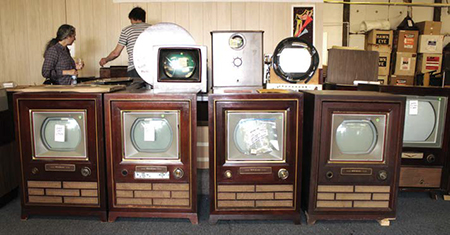$110,000 Raised to Preserve Television’s Technical History
HILLIARD, OHIO—This year’s Early Television Foundation conference broke ground on a number of fronts, including overall attendance and the amount of revenue generated from a live auction of equipment from television’s past. More than 130 individuals sharing an interest in preserving television’s technical history gathered in this Columbus suburb May 1–3 to trade information or deliver presentations on arcane technologies, purchase a heretofore unobtainable part for restoring an early set, or to bid on a large selection of complete vintage TVs offered at auction.

These four examples of RCA’s first production color receiver, the CT-100 which premiered in the spring of 1954, were part of the unusually large number of auction entries at this year’s Early Television Foundation conference. This year’s auction was of special interest to many conference participants as it contained a large number of rare items from the estate of television historian and collector Ed Reitan, who passed away in January.
Auction proceeds hit a record amount for the ETF event for the dozen or so years that it’s been held.
“The auction this year did something like $110,000, an all-time record high” said Steve McVoy, organizer of the event and founder of the ETF. “This was largely due to the price of some of the items in the Reitan estate.”
Included were three CBS field sequential color television receiving devices, four 1954 RCA CT-100 sets, an RCA pre-production Model 5 NTSC receiver, an RCA 1930s field test set, a pre-WWII DuMont receiver, a Western Television mechanical television receiver and RCA’s first color camera, the TK-40. Only a few of the items failed to meet reserves; the field test receiver was one of these with a reserve set at $35,000.
CATHODE RAY TUBE REBUILDING
Another feature of this year’s gathering of the TV techno-history faithful was an “open house” of the nearly completed CRT rebuilding operation that’s being created at the Early Television Foundation and Museum. It’s constructed from equipment donated by two now-defunct rebuilders—the Hawk-Eye Picture Tube Manufacturing Co. in Des Moines, Iowa and RACS, a French company. These were the last such businesses in the world and both have discontinued operations during the past five years due to the ascendency of flat-screen television displays. Once operational, it’s hoped that the ETF rebuilding plant will be able to provide antique TV set restorers with a source of CRTs for their projects.

Steve McVoyTECHNICAL PRESENTATIONS AND ATTRACTIONS
Following the Saturday morning live auction, several ETF members and invited guests presented papers on television’s technical history. These included a history of the development of RCA’s “SelectaVision” video disk, 1920s television, RCA’s color television development, a look at some very early recorded television programing excerpts, and an examination of TV engineering pioneer Vladimir Zworykin’s laboratory notebooks.
The professional video industry's #1 source for news, trends and product and tech information. Sign up below.
In addition to these “mainstream” activities, attendees were able to browse the ETF Museum’s extensive collection of television treasures, including two very new additions: a 1930s Hollis Baird drum scanner and a DuMont prototype NTSC color receiver that may have once graced the home of company founder Allan B. Du-Mont himself.
“The really nice thing about this year’s conference was the number of young people it attracted,” said McVoy.
More information about the Early Television Foundation and Museum and the annual ETF Conference is available at www.earlytelevision.org.
James E. O’Neal has more than 50 years of experience in the broadcast arena, serving for nearly 37 years as a television broadcast engineer and, following his retirement from that field in 2005, moving into journalism as technology editor for TV Technology for almost the next decade. He continues to provide content for this publication, as well as sister publication Radio World, and others. He authored the chapter on HF shortwave radio for the 11th Edition of the NAB Engineering Handbook, and serves as contributing editor of the IEEE’s Broadcast Technology publication, and as associate editor of the SMPTE Motion Imaging Journal. He is a SMPTE Life Fellow, and a member of the SBE and Life Senior Member of the IEEE.

